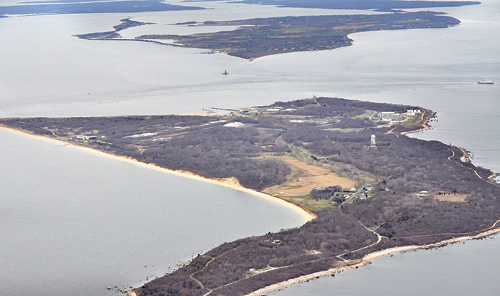What about all the wildlife on Plum Island?

Biologists have had little opportunity to examine wildlife on Plum Island, but the restricted-access island off Orient Point could prove to be the home of many rare species.
That’s the consensus of a study of the island’s biodiversity and ecology just released by the New York Natural Heritage Program.
Biologists Stephen Young and Matt Schlesinger presented their findings at a meeting organized by The Nature Conservancy at the Southold Town Recreation Center in Peconic Tuesday night.
Their work began with an overview of habitat types on the island, created by Heritage Program scientist Aissa Feldmann, who used Geographic Information System data to compile an inventory of its forests, scrublands, dunelands, bluffs and beach areas.
The scientists relied on the few inventories of plant and animal life on the island conducted over the past century. They estimated there have historically been about 420 types of plants on the island, 391 of which still exist.
One of the most prevalent of those plants is the beach plum, for which the island is named.
Mr. Young said there are 20 recorded rare plants on the island, 14 of which are still there, including an orchid known as Spring Ladies Tresses, whose population on Plum Island is one of the largest in the state.
He said there had historically been rare Atlantic white cedars in the southern wetlands on the island. They were cut down in the early 1900s, but the stumps can still be seen.
The island does suffer from some invasive species intrusion, he said, because of the human disturbance of the animal disease research laboratory and the former fort on the island.
“There’s a long history of disturbance on the island. The Indians were growing corn there,” he said. “At the military base, there’s a large mowed lawn. That has the potential to be restored to grassland, if people were interested in doing that.”
He said invasive species on the island include purple loosestrife, European giant reed, Asian bittersweet and autumn olive. He said those species could be controlled with enough effort and investment.
Mr. Schleshinger said the island is home to several animal species that are rare on Long Island, including the New England cottontail rabbit and 57 species of birds that are at risk in New York. He said the bird information is the most detailed, in part because the federal government has allowed the National Audubon Society regular access to the island for surveys.
Little is known about some other animal populations, such as reptiles, butterflies, bats and moths.
The scientists plan to make their data available to Southold Town to help in the town’s attempt to zone the island. The town had been waiting for data from the federal General Services Administration’s Environmental Impact Statement in order to begin its work zoning the island, but that document, which has been anticipated for months, is not slated to be ready until this fall.
John Turner, of the Save Plum Island Coalition, was at Tuesday’s meeting. He said the group’s goal is to keep the island in federal hands and have 80 to 90 percent of its 840-acre land area dedicated as a National Wildlife Refuge.
Randy Parsons of The Nature Conservancy, shares that view.
“Plum Island has a great unrealized potential to give its owners, the people of the United States,” he said.







